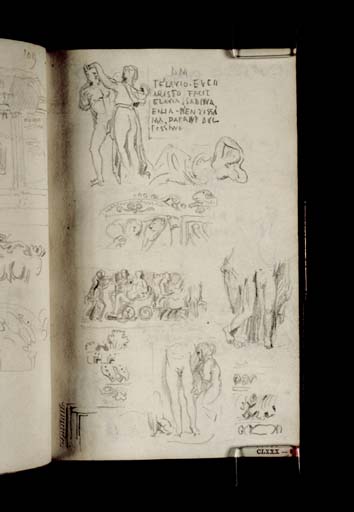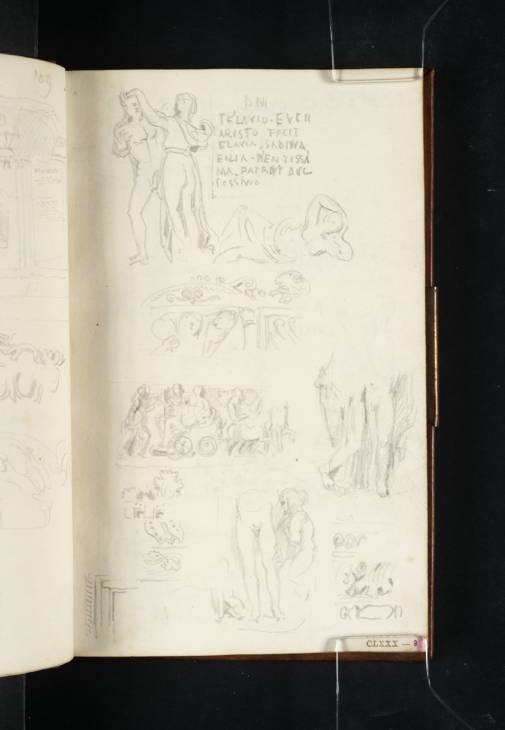Joseph Mallord William Turner Studies of Sculptural Fragments and Reliefs from the Vatican Museums, Including the Ash-Urn of T. Flavius Eucharistus, and the Statue Base of Attius Insteius Tertullus 1819
Image 1 of 2
-
 Joseph Mallord William Turner, Studies of Sculptural Fragments and Reliefs from the Vatican Museums, Including the Ash-Urn of T. Flavius Eucharistus, and the Statue Base of Attius Insteius Tertullus 1819
Joseph Mallord William Turner, Studies of Sculptural Fragments and Reliefs from the Vatican Museums, Including the Ash-Urn of T. Flavius Eucharistus, and the Statue Base of Attius Insteius Tertullus 1819 -
 Joseph Mallord William Turner, Studies of Sculptural Fragments and Reliefs from the Vatican Museums, Including the Ash-Urn of T. Flavius Eucharistus, and the Statue Base of Attius Insteius Tertullus 1819 (Enhanced image)Enhanced image
Joseph Mallord William Turner, Studies of Sculptural Fragments and Reliefs from the Vatican Museums, Including the Ash-Urn of T. Flavius Eucharistus, and the Statue Base of Attius Insteius Tertullus 1819 (Enhanced image)Enhanced image
Joseph Mallord William Turner,
Studies of Sculptural Fragments and Reliefs from the Vatican Museums, Including the Ash-Urn of T. Flavius Eucharistus, and the Statue Base of Attius Insteius Tertullus
1819
Joseph Mallord William Turner 1775–1851
Folio 10 Recto:
Studies of Sculptural Fragments and Reliefs from the Vatican Museums, Including the Ash-Urn of T. Flavius Eucharistus, and the Statue Base of Attius Insteius Tertullus 1819
D15121
Turner Bequest CLXXX 9
Turner Bequest CLXXX 9
Pencil on white wove paper, 161 x 101 mm
Inscribed by the artist in pencil (see main catalogue entry)
Inscribed by John Ruskin in red ink ‘9’ bottom right
Stamped in black ‘CLXXX 9’ bottom right
Inscribed by John Ruskin in red ink ‘9’ bottom right
Stamped in black ‘CLXXX 9’ bottom right
Accepted by the nation as part of the Turner Bequest 1856
References
1909
A.J. Finberg, A Complete Inventory of the Drawings of the Turner Bequest, London 1909, vol.I, p.531, ‘Various groups and portions of figures’.
1984
Cecilia Powell, ‘Turner on Classic Ground: His Visits to Central and Southern Italy and Related Paintings and Drawings’, unpublished Ph.D thesis, Courtauld Institute of Art, University of London 1984, pp.136 note 37, 412, 476 note 8, as ‘(a)-(d) Parts of the ash urn of T. Flavius Eucharistus (A, II, pl.25, 99a) (e)-(j) Parts of the base of the statue of Attius Insteius Tertullus (A, I, pl.25, 37)’.
1987
Cecilia Powell, Turner in the South: Rome, Naples, Florence, New Haven and London 1987, pp.51 note 6, 55 note 23, reproduced p.56 pl.62, as ‘A typical double-page spread of “Vatican fragments” ’.
2008
James Hamilton, Nicola Moorby, Christopher Baker and others, Turner e l’Italia, exhibition catalogue, Palazzo dei Diamanti, Ferrara 2008, pp.47, 91 note 52, reproduced in colour fig.27, as ‘Roma. Schizzi di sculture ai Musei Vaticani, con particolari dell urna cineraria di Flavio Eurcaristo e la parte inferiore della statua di Attio Insteio Tertullo’.
2009
James Hamilton, Nicola Moorby, Christopher Baker and others, Turner & Italy, exhibition catalogue, National Galleries of Scotland, Edinburgh 2009, pp.47, 151 note 52, reproduced in colour pl.49 p.46, as ‘Parts of the Ash Urn of T. Flavius Eucharistus; and Parts of the Base of the Statue of Attius Insteius Tertullus’.
During his 1819 stay in Rome, one of Turner’s most extensive sketching campaigns was the large number of pencil studies made from the sculpture collections of the Vatican Museums (for a general discussion, see the introduction to the sketchbook). This page contains sketches of various objects, most or all of which were probably found in the Galleria Lapidaria (Lapidary Gallery) of the Museo Chiaramonti. The studies are numbered from top left to bottom right:
a.
Cecilia Powell has identified this sketch as a fragment of the cinerarium, or ash urn, of T. Flavius Eucharistus,1 which is today found in the Cortile del Belvedere.2 Turner has transcribed the Latin inscription as ‘DM | T FLAVIO. EV CII | ARISTO FECIT | FLAVIA. SABINA | FILIA. RENTISSA | MA. PATRNI DVL | [?SESSINO]’. The first part translates as ‘D[is] M[anibus]’, ‘To the spirits of the departed’, and is a common phrase found on Roman funerary monuments.
b.
This appears to be a sketch of another cinerarium decorated with sculptural reliefs, although the object is currently unidentified.
Cecilia Powell has identified this sketch as a fragment of the cinerarium, or ash urn, of T. Flavius Eucharistus,1 which is today found in the Cortile del Belvedere.2 Turner has transcribed the Latin inscription as ‘DM | T FLAVIO. EV CII | ARISTO FECIT | FLAVIA. SABINA | FILIA. RENTISSA | MA. PATRNI DVL | [?SESSINO]’. The first part translates as ‘D[is] M[anibus]’, ‘To the spirits of the departed’, and is a common phrase found on Roman funerary monuments.
b.
This appears to be a sketch of another cinerarium decorated with sculptural reliefs, although the object is currently unidentified.
Cecilia Powell has identified the remaining sketches as various elements from the base of the statue of Attius Isteius Tertullus,3 found in the Galleria Lapidaria (Lapidary Gallery) of the Museo Chiaramonti.4 A general view of the sculpture can be found on folio 9 verso (D15120; Turner Bequest CLXXX 8a). The sketches comprise:
c.
Part of the relief panel and decorative border at the top of the base.
d.
A fragment of two figures in relief from the left-hand side of the base.
e.
Part of the ornamental border framing the upper corner of the base.
f.
A fragment of figures in relief from the right-hand side of the base.5
g.
Part of the ornamental border at the bottom of the base including an egg and dart style and decorative foliage pattern.
Part of the relief panel and decorative border at the top of the base.
d.
A fragment of two figures in relief from the left-hand side of the base.
e.
Part of the ornamental border framing the upper corner of the base.
f.
A fragment of figures in relief from the right-hand side of the base.5
g.
Part of the ornamental border at the bottom of the base including an egg and dart style and decorative foliage pattern.
Nicola Moorby
November 2009
See Walther Amelung, Die Sculpturen des Vaticanischen Museums, Berlin 1903–8, vol.II, ‘Belvedere II’, no.99a, pp.280–1, reproduced pl.25.
How to cite
Nicola Moorby, ‘Studies of Sculptural Fragments and Reliefs from the Vatican Museums, Including the Ash-Urn of T. Flavius Eucharistus, and the Statue Base of Attius Insteius Tertullus 1819 by Joseph Mallord William Turner’, catalogue entry, November 2009, in David Blayney Brown (ed.), J.M.W. Turner: Sketchbooks, Drawings and Watercolours, Tate Research Publication, December 2012, https://www

